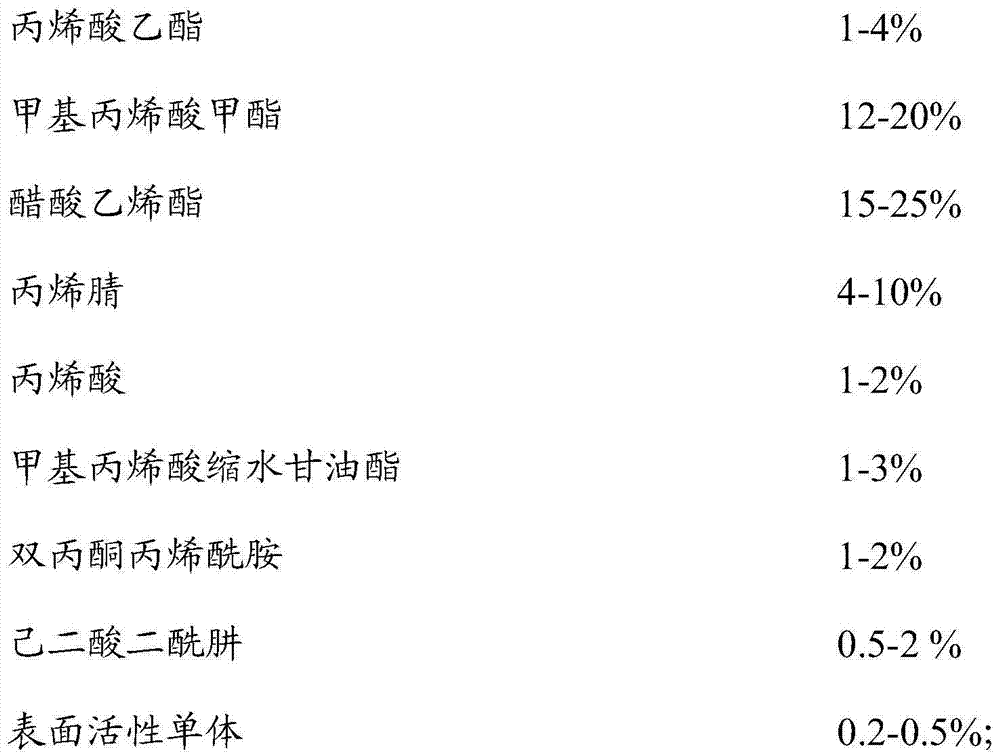Preparing method of modified acrylate emulsion
A technology of acrylate and methacrylate, which is applied in the field of preparation of modified acrylate emulsion, which can solve the problems of insufficient emulsification performance, sticky printing rubbing fastness, and difficulty in meeting requirements, etc., so as to improve printing color fastness and washing fastness, low gel rate and simple method
- Summary
- Abstract
- Description
- Claims
- Application Information
AI Technical Summary
Problems solved by technology
Method used
Image
Examples
Embodiment 1
[0033] Prepare the modified acrylate emulsion, comprising the following steps:
[0034] Stir 30g of n-butyl acrylate, 30g of methyl methacrylate and 30g of vinyl-terminated polydimethylsiloxane evenly to obtain a mixture with a viscosity of 20mPa·s at 25°C; among them, vinyl-terminated polydimethylsiloxane The vinyl mass content of the alkane is 0.2%, and the viscosity at 25°C is 1500mPa·s;
[0035] Add the mixture, 145g of n-butyl acrylate, 110g of vinyl acetate, 55g of methyl methacrylate, 40g of acrylonitrile, 6g of acrylic acid, 10g of glycidyl methacrylate, 5g of diacetone acrylamide, and 4g of adipic dihydrazide Pre-emulsify in 180g of water containing 3g of emulsifier to obtain a pre-emulsion; wherein, the emulsifier is obtained by compounding Clarient's Emulsogen EPA073 and Clarient's Emulsogen LXN407 at a mass ratio of 3:5;
[0036] Mix 2g of allyloxy hydroxypropyl sodium sulfonate, 5g of emulsifier and 280g of water evenly and then heat up to 75°C, add 10g of ethyl ...
Embodiment 2
[0047] Prepare the modified acrylate emulsion, comprising the following steps:
[0048] Stir 30g of n-butyl acrylate, 50g of methyl methacrylate and 40g of vinyl-terminated polydimethylsiloxane evenly to obtain a mixture with a viscosity of 20mPa·s at 25°C; among them, vinyl-terminated polydimethylsiloxane The vinyl mass content of the alkane is 0.3%, and the viscosity at 25°C is 1000mPa·s;
[0049] The mixture, n-butyl acrylate 200g, vinyl acetate 75g, methyl methacrylate 20g, acrylonitrile 20g, acrylic acid 9g, glycidyl methacrylate 8g, diacetone acrylamide 6g, adipate dihydrazide 4.8 g was added into 180 g of water containing 4 g of emulsifier for pre-emulsification to obtain a pre-emulsion; wherein, the emulsifier was obtained by compounding Clarient's Emulsogen EPA073 and Clarient's Emulsogen LXN407 at a mass ratio of 1:2;
[0050] Mix 1g of allyloxy hydroxypropyl sodium sulfonate, 2g of emulsifier and 280g of water evenly, then heat up to 75°C, add 14g of ethyl acrylate...
Embodiment 3
[0055] Prepare the modified acrylate emulsion, comprising the following steps:
[0056] Stir 40g of n-butyl acrylate, 20g of methyl methacrylate and 30g of vinyl-terminated polydimethylsiloxane evenly to obtain a mixture with a viscosity of 20mPa·s at 25°C; wherein, vinyl-terminated polydimethylsiloxane The vinyl mass content of alkanes is 0.4%, and the viscosity at 25°C is 1500mPa·s;
[0057] The above mixture, n-butyl acrylate 170g, vinyl acetate 100g, methyl methacrylate 60g, acrylonitrile 20g, acrylic acid 6g, glycidyl methacrylate 10g, diacetone acrylamide 5g, adipate dihydrazide 4g Add 180g of water containing 3g of emulsifier for pre-emulsification to obtain a pre-emulsion; wherein, the emulsifier is obtained by compounding Clarient's Emulsogen EPA073 and Clarient's Emulsogen LXN407 at a mass ratio of 3:5;
[0058] After mixing 2g allyloxy hydroxypropyl sodium sulfonate, 5g emulsifier and 280g water, the temperature was raised to 75°C, and 8g ethyl acrylate, 6g methyl ...
PUM
| Property | Measurement | Unit |
|---|---|---|
| viscosity | aaaaa | aaaaa |
| viscosity | aaaaa | aaaaa |
| particle diameter | aaaaa | aaaaa |
Abstract
Description
Claims
Application Information
 Login to View More
Login to View More - R&D
- Intellectual Property
- Life Sciences
- Materials
- Tech Scout
- Unparalleled Data Quality
- Higher Quality Content
- 60% Fewer Hallucinations
Browse by: Latest US Patents, China's latest patents, Technical Efficacy Thesaurus, Application Domain, Technology Topic, Popular Technical Reports.
© 2025 PatSnap. All rights reserved.Legal|Privacy policy|Modern Slavery Act Transparency Statement|Sitemap|About US| Contact US: help@patsnap.com



